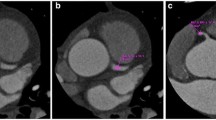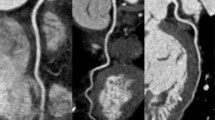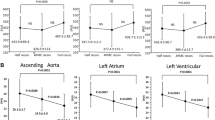Abstract
Purpose
We aimed to compare the radiation dose and image quality of a minimal phase window centered at 77 % compared with a wide phase window in coronary CT angiography using the second-generation 320-row CT.
Materials and methods
Eighty patients with heart rate ≤75 bpm were retrospectively included. The first 40 patients underwent scanning with a wide phase window (65–85 %), while the last 40 patients underwent scanning with a minimal phase window centered at 77 %. Subjective image quality was graded using a 4-point scale (4 = excellent). Image noise and contrast-to-noise ratio at the proximal segments were also analyzed. The mean effective dose was derived from the dose length product multiplied by a chest conversion coefficient (κ = 0.014 mSv mGy−1 cm−1).
Results
Minimal phase window scanning centered at 77 % reduced the radiation dose by 30 % compared with wide phase window scanning (1.7 vs 2.4 mSv, p = 0.0009). The subjective image quality showed no significant difference (3.75 vs 3.76, p = 0.77). No significant difference was observed in the image noise, CT number, and contrast-to-noise ratio.
Conclusions
Radiation dose could be reduced while maintaining image quality by use of a minimal phase window centered at 77 % compared with a wide phase window in coronary CT angiography using the second generation 320-row CT.

Similar content being viewed by others
References
Hsiao EM, Rybicki FJ, Steigner M. CT coronary angiography: 256-slice and 320-detector row scanners. Curr Cardiol Rep. 2010;12:68–75.
Steigner ML, Otero HJ, Cai T, Mitsouras D, Nallamshetty L, Whitmore AG, et al. Narrowing the phase window width in prospectively ECG-gated single heartbeat 320-detector row coronary CT angiography. Int J Cardiovasc Imaging. 2009;25:85–90.
Tomizawa N, Nojo T, Akahane M, Torigoe R, Kiryu S, Ohtomo K. Adaptive iterative dose reduction in coronary CT angiography using 320-row CT: assessment of radiation dose reduction and image quality. J Cardiovasc Comput Tomogr. 2012;6:318–24.
Tomizawa N, Nojo T, Akahane M, Torigoe R, Kiryu S, Ohtomo K. Shorter delay time reduces interpatient variability in coronary enhancement in coronary CT angiography using the bolus tracking method with 320-row CT. Int J Cardiovasc Imaging. 2013;29:185–90.
Chen MY, Steigner ML, Leung SW, Kumamaru KK, Schultz K, Mather RT, et al. Simulated 50% radiation dose reduction in coronary CT angiography using adaptive iterative dose reduction in three dimensions (AIDR3D). Int J Cardiovasc Imaging. 2013;29:1167–75.
Bedayat A, Rybicki FJ, Kumamaru KK, Powers SL, Signorelli J, Steigner ML, et al. Reduced exposure using asymmetric cone beam processing for wide area detector cardiac CT. Int J Cardiovasc Imaging. 2012;28:381–8.
Raff GL, Abidov A, Achenbach S, Berman DS, Boxt LM, Budoff MJ, et al. SCCT guidelines for the interpretation and reporting of coronary computed tomographic angiography. J Cardiovasc Comput Tomogr. 2009;3:122–36.
Tomizawa N, Komatsu S, Akahane M, Torigoe R, Kiryu S, Ohtomo K. Relationship between beat to beat coronary artery motion and image quality in prospectively ECG-gated two heartbeat 320-detector row coronary CT angiography. Int J Cardiovasc Imaging. 2012;28:139–46.
Leipsic J, LaBounty TM, Ajlan AM, Earls JP, Strovski E, Madden M, et al. A prospective randomized trial comparing image quality, study interpretability, and radiation dose of narrow acquisition window with widened acquisition window protocols in prospectively ECG-triggered coronary computed tomography angiography. J Cardiovasc Comput Tomogr. 2012;7:18–24.
Halliburton SS, Abbara S, Chen MY, Gentry R, Mahesh M, Raff GL, et al. SCCT guidelines on radiation dose and dose-optimization strategies in cardiovascular CT. J Cardiovasc Comput Tomogr. 2011;5:198–224.
Zhang C, Zhang Z, Yan Z, Xu L, Yu W, Wang R. 320-row CT coronary angiography: effect of 100-kV tube voltages on image quality, contrast volume, and radiation dose. Int J Cardiovasc Imaging. 2011;27:1059–68.
Motoyama S, Sarai M, Harigaya H, Anno H, Inoue K, Hara T, et al. Computed tomographic angiography characteristics of atherosclerotic plaques subsequently resulting in acute coronary syndrome. J Am Coll Cardiol. 2009;54:49–57.
Conflict of interest
Rumiko Torigoe is an employee of Toshiba Medical Systems Corporation. The other authors declare that they have no conflict of interest.
Author information
Authors and Affiliations
Corresponding author
Appendix
Appendix
In order to determine the optimal phase for a minimal phase window, the records of 375 consecutive patients who underwent coronary CT angiography from January to December 2012 were retrospectively examined. Diastolic phase was used for reconstruction in 286 of these patients, and the average (±standard deviation) phase with minimum motion artifacts was 77.2 ± 3.5 % of the RR interval. Thus, we set the target phase to 77 % when coronary CT angiography was performed with a minimal phase window.
About this article
Cite this article
Tomizawa, N., Kanno, S., Maeda, E. et al. Minimizing the acquisition phase in coronary CT angiography using the second generation 320-row CT. Jpn J Radiol 32, 391–396 (2014). https://doi.org/10.1007/s11604-014-0321-1
Received:
Accepted:
Published:
Issue Date:
DOI: https://doi.org/10.1007/s11604-014-0321-1




